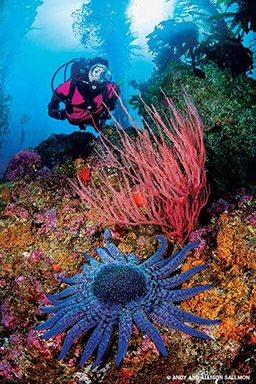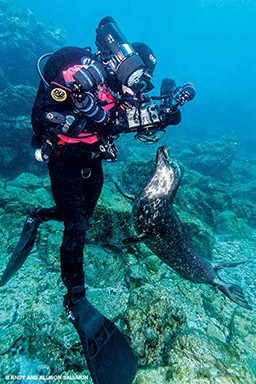I blink the sleep out of my eyes and squint at the ceiling of my bunk in the semidarkness. I can hear faint creaking of the boat, whose slight movements indicate that either the seas are very calm today or we’re anchored in a well-protected cove. I detect the aroma of frying bacon and hear muted voices, but nothing suggests an answer to the question in my mind. I swing my legs out of bed, hop to the ground and grope my way to the stairs, finally allowing my thoughts to bubble to the surface.
“Where the heck am I?” I whisper furtively.

This might sound like a bad scenario, but it’s not an uncommon sunrise contemplation for divers who have booked a charter to Santa Barbara Island, a tiny spit of land 38 miles off the California coast. Approximately one square mile in area and the highest peak at 634 feet, it is the smallest of California’s Channel Islands. Its isolation and small size translate to minimal shelter from large swell, so it is only diveable in optimal conditions. The island’s distance from the mainland complicates matters further — most charters involve an overnight trip.
Hopeful passengers board in the evening, strap down their gear and hoist themselves into bunks, all the while praying that the Pacific Ocean will cooperate. More often than not, they wake to discover that they are anchored in a more forgiving location, such as the protected eastern side of much-larger Catalina Island. Perseverance is critical, however, since Santa Barbara Island can deliver features of both the southern and northern Channel Islands, and it does so with bonus perks such as crystal-clear blue water and pelagic creatures.
For the past 10 months my attempts to reach Santa Barbara Island have been unsuccessful, so I pad up the stairs to the galley, muttering apprehensively, “What will it be this time? Small island or big island? Small? Or big?” When I reach the top of the stairs, I exhale and lift my eyes slowly toward the window, and I cannot help the smile that overtakes me: We’ve made it! Glinting in the sun is my tiny spit of land, a place that to many represents the capstone of California Channel Islands diving.
My dive buddy is already on deck, swigging coffee while he double-checks his gear, and we look at one another in delight, wordlessly agreeing that we will be in the water as soon as the gates are opened for diving. A quick look at our surroundings further improves my giddy mood. The glass-calm sea has allowed us to anchor at one of Santa Barbara Island’s most exposed sites, Arch Reef, identifiable by the boiling appearance of the water where the namesake topology nearly breaks the surface.

Under the ocean’s surface, a 30-foot-wide sponge- and Corynactis-encrusted archway dominates the scene. It would be easy to spend the entire dive in less than 45 feet of water exploring the large rock structure, but we have other goals. Passing through the arch, we leave the other divers behind and head northwest through a sloping, bat-ray-patrolled kelp forest to reach Hidden Reef. At 60 feet, the slope quickly drops off to form a rocky miniwall that provides hiding spots for lobsters and substrate for large red gorgonians and clumps of purple hydrocoral. Large lingcod and California scorpionfish watch us alongside brightly colored starfish.
When we turn back toward the boat we see a strange, silvery mass in the distance. As it approaches, we recognize it as a vast school of mackerel. Seconds later we are surrounded by chaos, the glittering school of baitfish swirling around us while a small mob of young adult sea lions herds the panicked fish through the kelp and toward deep water.
As the morning progresses, the ocean remains glass calm, so we motor south toward tiny Sutil Island. While the captain is anchoring near the south side of the island, I see a sweet, spotted face blinking beckoningly at us from the surface: a harbor seal. Since I have managed to photograph only one or two of these timid creatures in all my years of diving, I recognize the ruse for what it is. I nudge my buddy and gesture in exasperation toward the seal. My buddy laughs and responds in a mocking voice, “Oh, look at me! I’m a wonderfully adorable seal. And I will wonderfully disappear the second you’re underwater.” Snickering, we gear up and hop in, steering around the patchy kelp to get to Sutil Pass, which runs between Sutil and Santa Barbara islands.

We pass red and two-spot octopuses, an unusual variety of nudibranchs and island kelpfish on the rocks. As we reach a depth of 60 feet the kelp forms a dense forest lined by red and golden gorgonians and teeming with blacksmith. We’re photographing the scene when I feel a quick tug at my left foot. I glance back to discover my fin tip in the mouth of the juvenile harbor seal, which has followed us into the pass.
As you might have surmised, standard harbor seal behavior sends the creature fleeing in apparent shock as soon as a diver locks eyes with it. However, this particular seal seems stubbornly, oddly, determined to become my best friend. After he finishes chewing on my fin, he decides to frisk his way up my legs, nuzzle my camera housing and wrap himself around my head. When the process is complete, he swims a few feet away, only to return to my fins and start from square one. This inspection is repeated several times, making me laugh so hard that it is all I can do to keep my regulator in my mouth. At last, my new best friend seems satisfied with his thorough evaluation and swims off, leaving us in hysterics and low enough on air that we decide to head back to the boat.
Since we seem to be on a roll, we ask the captain about the possibility of diving with angel sharks. Santa Barbara Island is one of the best places in Southern California to view these flat, raylike sharks, but we haven’t seen many in the past couple of years. As it turns out, we’re in luck: The other divers are just as excited about the idea, and the crew has a secret spot that nearly always delivers.

We motor around the northern tip of the island toward Elephant Seal Cove and anchor near Shag Rock. At first we’re a bit dejected not to see any of the namesake seals in the area, but our disappointment is short-lived. When we descend into 35 feet of hazy blue water, the first thing we see is a pair of angel sharks lying on top of the sand. The site itself, a few urchin-covered rocks scattered across a sandy bottom, may not seem terribly exciting, but during the course of our dive we come across a total of six angel sharks (more than we’ve ever seen in a dive day) and several bat rays as well.
Long before we reach it, we can hear barking from The Rookery, one of the largest colonies of California sea lions in the state (and consequently, one of the best places in the world to view them in the water). The boat has hardly stopped moving when a flotilla of boisterous adolescents approaches, stridently insisting that all divers proceed into the water immediately. We obey their demands and promptly find ourselves mobbed. Young sea lions are everywhere, chewing on our hoods, fins and strobes. The pandemonium continues for a short while, and then as rapidly as they appeared, the sea lions depart in a yapping, bubble-filled swoosh.
We take advantage of the momentary tranquility to explore the nearby kelp, where we discover giant kelpfish shyly weaving through the forest and small California sea hares climbing the leaves. Before long, the pack of sea lions has returned, and they demand our full attention until it’s time to end the dive. We’re given a noisy, splashing escort all the way back to the dive platform, at which point we bid farewell to our raucous companions and pack for home.
The motor starts up, and as the boat turns toward the mainland there is no question about where we are. We’re alongside our favorite (We’ll say it!) of the Channel Islands, contemplating a remarkable day as our gear dries in the late afternoon sun. We watch as that tiny spit of land gets smaller on the horizon, fading between blue water and sky.
How To Dive It

Getting There: Dive charters originate from Santa Barbara, Ventura, San Pedro/Long Beach and San Diego. The crossing takes approximately six hours, so most boats board and depart at night, arriving early the next morning. Santa Barbara Island is also a common destination for multiday Channel Island trips that can also include stops at other islands such as San Clemente, Anacapa and Catalina.
Conditions: Water temperatures range from 50-65°F depending on the season, depth and currents. Full 7mm wetsuits with hoods and gloves are necessary year-round, with drysuits a better choice in the cooler winter and spring months. Visibility is often good to excellent, ranging from 40 feet near the sea lion rookery to more than 100 feet on the exposed backside of the island. Due to the offshore location of the island and the possibility of rapidly changing conditions, surge and current, most sites are considered intermediate to advanced.
Topside Adventure: Santa Barbara Island is a seabird nesting site and is also home to several colonies of pinnipeds. Hiking is allowed, and the steep trail leading to the island’s sea cliffs is accessible by boat at the Landing Cove dock. Blue, gray and humpback whales can be spotted during their northern and southern migrations, as can large pods of Pacific white-sided, common and Risso’s dolphins, meaning that the crossing can be nearly as exciting as the diving.
© Alert Diver — Q2 Spring 2015